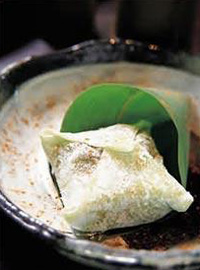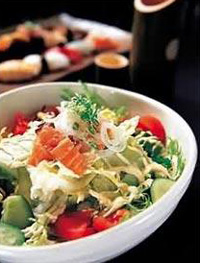Capital concept rolls into Shanghai
Updated: 2007-03-23 10:08
 There are not a lot of places that local residents get to say are cool. A major metropolis such as this really ought to feature more interesting eating establishments than it already does, but as things stand, any old Charlie with a half-decent idea off the beaten track gets celebrated for his so-called ingenuity.
There are not a lot of places that local residents get to say are cool. A major metropolis such as this really ought to feature more interesting eating establishments than it already does, but as things stand, any old Charlie with a half-decent idea off the beaten track gets celebrated for his so-called ingenuity.
Mention Japanese fare to most city folk and the first impression that comes to mind is the scores of all-you-can-eat joints where you pay your money and take your chances. These are places that one does not often have to worry about cost but would have to question the quality of ingredients.
On the other hand, top-drawer fare from the Land of the Rising Sun often commands prices beyond the reach of most mortals. The food is infinitely better, but when the final bill is proffered you may wished the figures were in yen.
Haiku by Hatsune plays on a winning formula that has already proven its salt in Beijing. The Taojiang Road sushi bar is importing its capital-city concept lock, stock and barrel and is going for the mid-market segment where diners get a comfortable feed in pleasant surroundings without an outrageous bill.
Haiku is a destination worth talking about. Not just in the I-have-been- there sense, but it also has an ability to stimulate conversation during the meal itself.
For starters, this is a classic fusion restaurant - traditional preparation done in a modern vein. This concept kicked off in California in the late 1980s at the height of Japan Inc fever and has since defied expectations by riding the wave intact into the 21st century.
An often-heard lament is that some chefs merely chuck on a few ingredients from a different time zone and voila, it is fusion.
 Japanese fare, as the original model for the style, lends itself nicely to American preparation.
Japanese fare, as the original model for the style, lends itself nicely to American preparation.
The US West Coast enjoys similar fruits from the Pacific Ocean but residents there have more of a baby's palate in comparison.
These are the first tastes that a newborn is exposed to and these preferences carry on to adulthood.
The California roll which started the sushi craze in the United States is a perfect example. Made with imitation crab, cucumber and avocado then rolled in rice before being coated in tobiko (flying fish roe), the oily avocado and often-sweet mayonnaise have been credited with easing diners into more exotic options.
Haiku offers a California roll (50 yuan/US$6.50) to pay homage, but its strength lies elsewhere. The gorgeous, almost zen-like coolness that resonates through the 110-seat premise is home to a few more challenging creations.
The 119 roll (55 yuan) is a spicy tuna rice offering; the famed moto-roll-ah is not just a funky name but also a delightful play on textures, especially if consumed the way Malaysian owner Vincent Liu suggests - in a single bite.
A challenge would be to try all 30 kinds of roll on offer. This is half the number of those served at Hatsune in Beijing. Given that the local chefs are trained by their northern counterparts, however, it is only a matter of time before the three-month-old restaurant can reproduce all 60.
Haiku also offers typical Japanese dishes and most have been given the fusion touch. Steak misoyaki is in fact grilled beef with sauce - typically a French approach. However, the miso sauce altered the flavor enough to warrant the fusion tag.
The ingredients are tantalizingly fresh considering the mid-price point, and the kitchen pays good attention to cleanliness and hygiene. This is a restaurant one can feel safe visiting, and coming back to again and again.
The wine list is also worth mentioning as it offers suitable pairings for the delicate dishes.
All in all the dining experience at Haiku is highly recommended. This is a concept that works, and in this often gastronomically-confused city, that alone is manna from heaven.
Haiku
Address: 28B Taojiang Road
Tel: 021-64450021
|
||
|
||
| Eating out:
Arriba arrives in the Wu
Bars&Cafes: Mare's milk a-go-go Weekend&Holiday: Ancient sites re-open after renovation Shopping: Jimmy Choo comes What's on: New shows on stage |
|
||
| Eating out:
Moroccan roll
Bars&Cafes: A boonna in training Weekend&Holiday: Pop power Shopping: LV boutique in E. China closed for disqualification What's on: Jazz-infused journey through Kunqu Opera |

